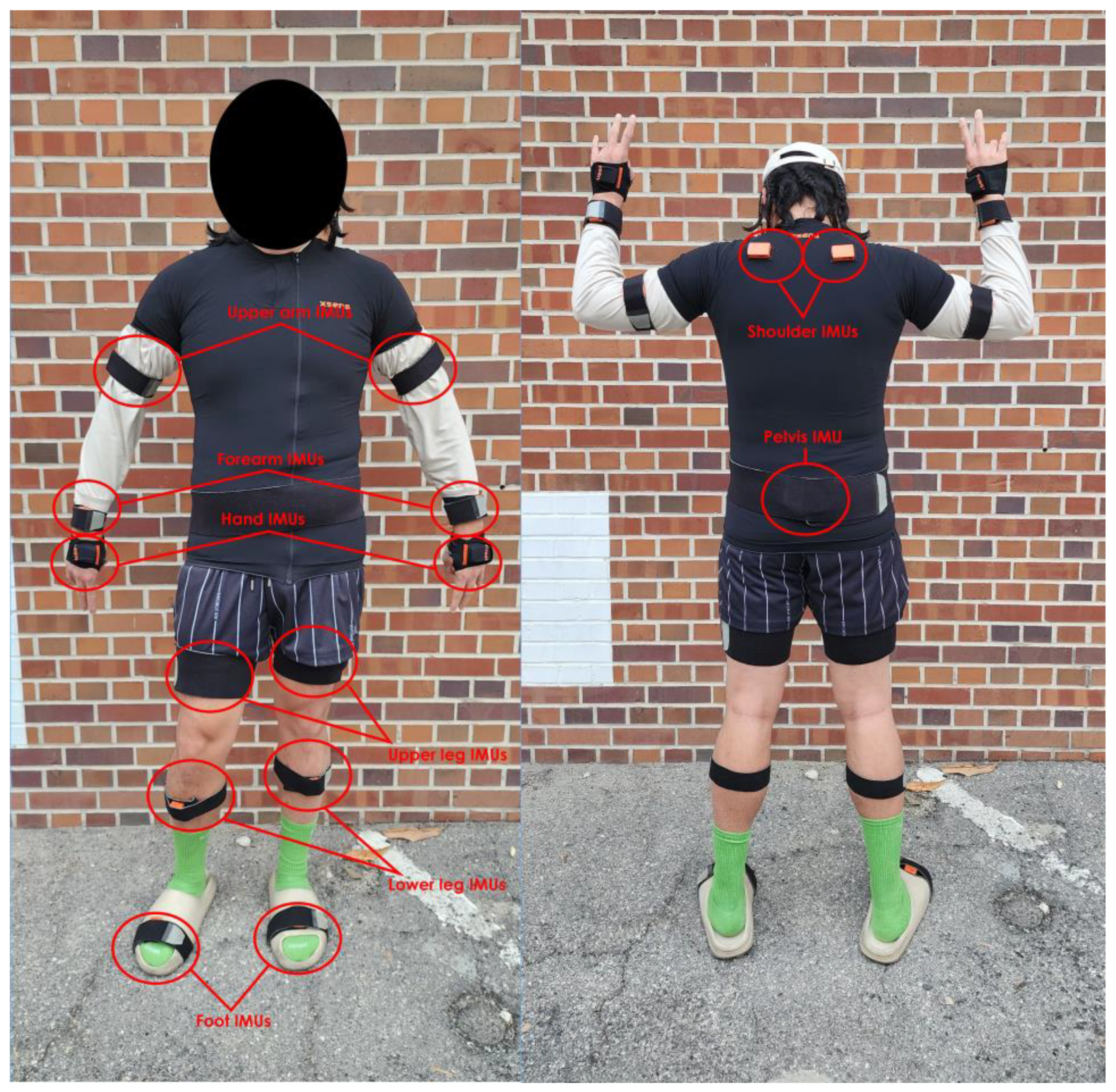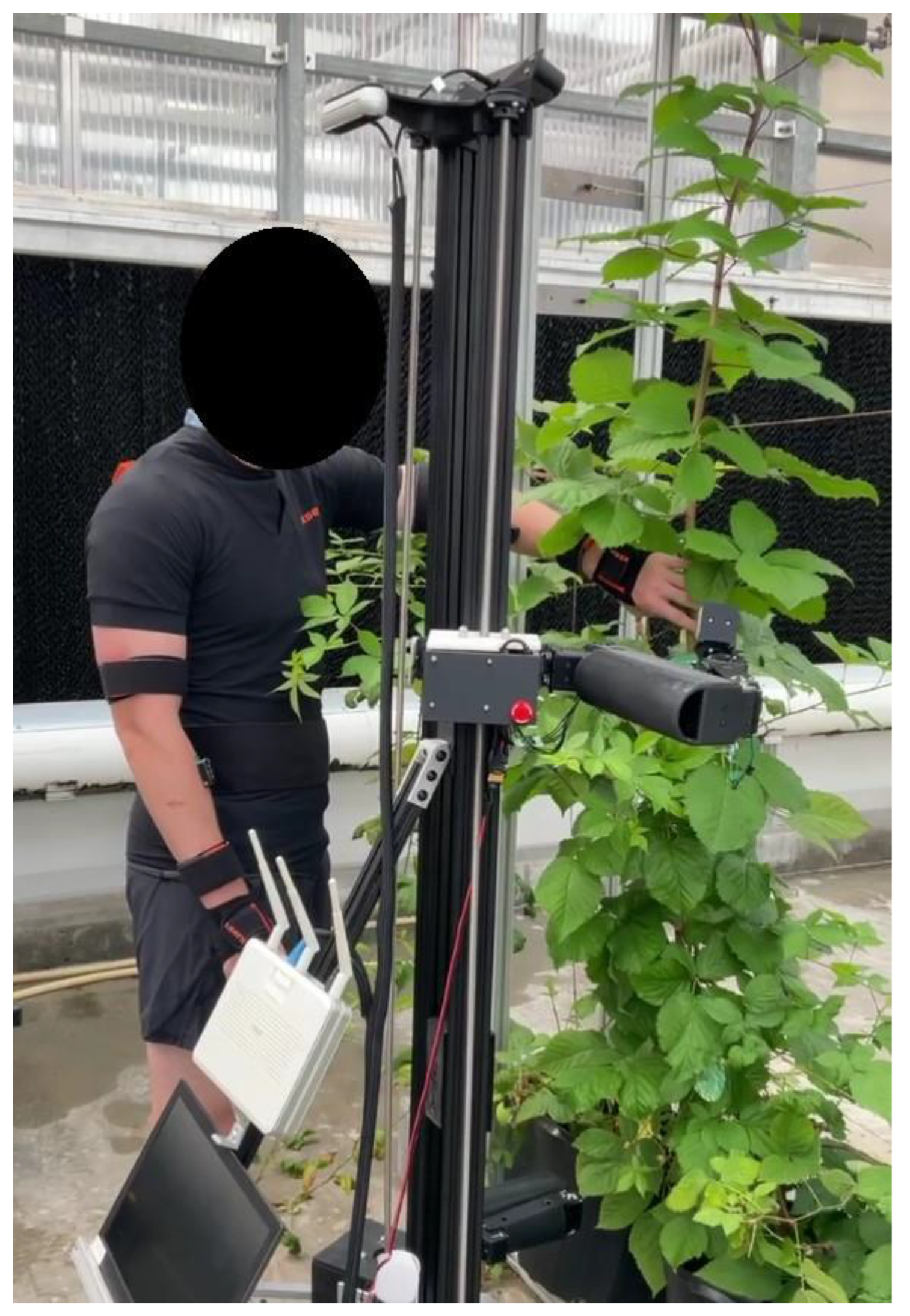Wearable Sensors Assess the Effects of Human–Robot Collaboration in Simulated Pollination
Abstract
:1. Introduction
2. Related Work
2.1. Pollination Robots
2.2. Studies on the Biomechanical Effects of HRC
3. Methods
3.1. Participants
3.2. Bioinstrumentation
3.3. Experiment Setup and Task Description
3.4. Protocol
3.5. Data Processing and Statistical Analysis
4. Results
5. Discussion
6. Conclusions
Author Contributions
Funding
Institutional Review Board Statement
Informed Consent Statement
Data Availability Statement
Conflicts of Interest
References
- Guerra-Sanz, M. Crop pollination in greenhouses. In Bee Pollination in Agrcultural Ecosystems; Oxford University Press: Oxford, UK, 2008; pp. 27–47. [Google Scholar]
- Potts, S.G.; Biesmeijer, J.C.; Kremen, C.; Neumann, P.; Schweiger, O.; Kunin, W.E. Global pollinator declines: Trends, impacts and drivers. Trends Ecol. Evol. 2010, 25, 345–353. [Google Scholar] [CrossRef] [PubMed]
- Williams, G.R.; Tarpy, D.R.; Chauzat, M.P.; Cox-Foster, D.L.; Delaplane, K.S.; Neumann, P.; Pettis, J.S.; Rogers, R.E.L.; Shutler, D. Colony collapse disorder in context. Bioessays 2010, 32, 845–846. [Google Scholar] [CrossRef] [PubMed]
- Ohi, N.; Lassak, K.; Watson, R.; Strader, J.; Du, Y.; Yang, C.; Hedrick, G.; Nguyen, J.; Harper, S.; Reynolds, D.; et al. Design of an autonomous precision pollination robot. In Proceedings of the 2018 IEEE/RSJ International Conference on Intelligent Robots and Systems (IROS), Madrid, Spain, 1–5 October 2018; IEEE: Piscataway, NJ, USA, 2018; pp. 7711–7718. [Google Scholar]
- Strader, J.; Nguyen, J.; Tatsch, C.; Du, Y.; Lassak, K.; Buzzo, B.; Watson, R.; Cerbone, H.; Ohi, N.; Yang, C.; et al. Flower interaction subsystem for a precision pollination robot. In Proceedings of the 2019 IEEE/RSJ International Conference on Intelligent Robots and Systems (IROS), Macau, China, 3–8 November 2019; IEEE: Piscataway, NJ, USA, 2019; pp. 5534–5541. [Google Scholar]
- Williams, H.; Nejati, M.; Hussein, S.; Penhall, N.; Lim, J.Y.; Jones, M.H.; Bell, J.; Ahn, H.S.; Bradley, S.; Schaare, P.; et al. Autonomous pollination of individual kiwifruit flowers: Toward a robotic kiwifruit pollinator. J. Field Robot. 2019, 37, 246–262. [Google Scholar] [CrossRef]
- Chen, Y.; Luo, Y.; Yerebakan, M.O.; Xia, S.; Behdad, S.; Hu, B. Human workload and ergonomics during human-robot collaborative electronic waste disassembly. In Proceedings of the 2022 IEEE 3rd International Conference on Human-Machine Systems (ICHMS), Orlando, FL, USA, 17–19 November 2022; IEEE: Piscataway, NJ, USA, 2022; pp. 1–6. [Google Scholar]
- Xie, Z.; Lu, L.; Wang, H.; Su, B.; Liu, Y.; Xu, X. Improving Workers’ Musculoskeletal Health During Human-Robot Collaboration through Reinforcement Learning. Hum. Factors 2023, 00187208231177574. [Google Scholar] [CrossRef]
- Tkach, I.; Bechar, A.; Edan, Y. Switching between collaboration levels in a human–robot target recognition system. IEEE Trans. Syst. Man Cybern. Part C (Appl. Rev.) 2011, 41, 955–967. [Google Scholar] [CrossRef]
- Dimitropoulos, N.; Togias, T.; Zacharaki, N.; Michalos, G.; Makris, S. Seamless human–robot collaborative assembly using artificial intelligence and wearable devices. Appl. Sci. 2021, 11, 5699. [Google Scholar] [CrossRef]
- Wang, X.; Veeramani, D.; Zhu, Z. Wearable Sensors-Based Hand Gesture Recognition for Human–Robot Collaboration in Construction. IEEE Sens. J. 2022, 23, 495–505. [Google Scholar] [CrossRef]
- Wood, R.; Nagpal, R.; Wei, G.Y. Flight of the robobees. Sci. Am. 2013, 308, 60–65. [Google Scholar] [CrossRef]
- Chechetka, S.A.; Yu, Y.; Tange, M.; Miyako, E. Materially engineered artificial pollinators. Chem 2017, 2, 224–239. [Google Scholar] [CrossRef]
- Yang, X.; Miyako, E. Soap bubble pollination. iScience 2020, 23, 101188. [Google Scholar] [CrossRef]
- Thomas, C.; Stankiewicz, L.; Grötsch, A.; Wischniewski, S.; Deuse, J.; Kuhlenkötter, B. Intuitive work assistance by reciprocal human- robot interaction in the subject area of direct human-robot collaboration. Procedia CIRP 2016, 44, 275–280. [Google Scholar] [CrossRef]
- Ganglbauer, M.; Ikeda, M.; Plasch, M.; Pichler, A. Human in the loop online estimation of robotic speed limits for safe human-robot collaboration. Procedia Manuf. 2020, 51, 88–94. [Google Scholar] [CrossRef]
- Figueredo, L.F.; Aguiar, R.D.C.; Chen, L.; Richards, T.C.; Chakrabarty, S.; Dogar, M. Planning to minimize the human muscular effort during forceful human-robot collaboration. ACM Trans. Hum.-Robot. Interact. (THRI) 2021, 11, 1–27. [Google Scholar] [CrossRef]
- Kim, W.; Peternel, L.; Lorenzini, M.; Babič, J.; Ajoudani, A. A human-robot collaboration framework for improving ergonomics during dexterous operation of power tools. Robot. Comput. Integr. Manuf. 2020, 68, 102084. [Google Scholar] [CrossRef]
- Seyyedhasani, H.; Peng, C.; Jang, W.-j.; Vougioukas, S.G. Collaboration of human pickers and crop- transporting robots during harvesting–part ii: Simulator evaluation and robot-scheduling case-study. Comput. Electron. Agric. 2020, 172, 105323. [Google Scholar] [CrossRef]
- Pal, A.; Leite, A.C.; Gjevestad, J.G.; From, P.J. A video-based human activity and motion direction classification framework for agricultural fields. In Proceedings of the 2021 6th Asia-Pacific Conference on Intelligent Robot Systems (ACIRS), Tokyo, Japan, 16–18 July 2021; pp. 1–7. [Google Scholar]
- Chen, W.; Yu, C.; Tu, C.; Lyu, Z.; Tang, J.; Ou, S.; Fu, Y.; Xue, Z. A survey on hand pose estimation with wearable sensors and computer-vision-based methods. Sensors 2020, 20, 1074. [Google Scholar] [CrossRef]
- Al-Yacoub, A.; Buerkle, A.; Flanagan, M.; Ferreira, P.; Hubbard, E.M.; Lohse, N. Effective human-robot collaboration through wearable sensors. In Proceedings of the 2020 25th IEEE International Conference on Emerging Technologies and Factory Automation (ETFA), Vienna, Austria, 8–11 September 2020; IEEE: Piscataway, NJ, USA, 2020; Volume 1, pp. 651–658. [Google Scholar]
- Škulj, G.; Vrabič, R.; Podržaj, P. A wearable imu system for flexible teleoperation of a collaborative industrial robot. Sensors 2021, 21, 5871. [Google Scholar] [CrossRef]
- Benos, L.; Kokkotis, C.; Tsatalas, T.; Karampina, E.; Tsaopoulos, D.; Bochtis, D. Biomechanical effects on lower extremities in human-robot collaborative agricultural tasks. Appl. Sci. 2021, 11, 11742. [Google Scholar] [CrossRef]
- Hopko, S.K.; Mehta, R.K.; Pagilla, P.R. Physiological and perceptual consequences of trust in collaborative robots: An empirical investigation of human and robot factors. Appl. Ergon. 2023, 106, 103863. [Google Scholar] [CrossRef]
- Cheng, Z.; Zhang, F. Flower end-to-end detection based on YOLOv4 using a mobile device. Wirel. Commun. Mob. Comput. 2020, 2020, 8870649. [Google Scholar] [CrossRef]
- Paulich, M.; Schepers, M.; Rudigkeit, N.; Bellusci, G. Xsens MTw Awinda: Miniature Wireless Inertial-Magnetic Motion Tracker for Highly Accurate 3D Kinematic Applications; Xsens: Enschede, The Netherlands, 2018; pp. 1–9. [Google Scholar]
- Lilliefors, H.W. On the Kolmogorov-Smirnov test for normality with mean and variance unknown. J. Am. Stat. Assoc. 1967, 62, 399–402. [Google Scholar] [CrossRef]
- Girden, E.R. ANOVA: Repeated Measures; SAGE: New York, NY, USA, 1992; p. 84. [Google Scholar]
- Muller, K.E.; Barton, C.N. Approximate power for repeated-measures ANOVA lacking sphericity. J. Am. Stat. Assoc. 1989, 84, 549–555. [Google Scholar] [CrossRef]
- Álvarez, D.; Alvarez, J.C.; González, R.C.; López, A.M. Upper limb joint angle measurement in occupational health. Comput. Methods Biomech. Biomed. Eng. 2016, 19, 159–170. [Google Scholar] [CrossRef] [PubMed]
- Singh, R.K.; Rai, N.; Singh, M.; Saha, S.; Singh, S.N. Detection of tomato leaf curl virus resistance and inheritance in tomato (Solanum lycopersicum L.). J. Agric. Sci. 2015, 153, 78–89. [Google Scholar] [CrossRef]
- Heidenreich, C.; Pritts, M.; Demchak, K.; Hanson, E.; Weber, C.; Kelly, M.J. High Tunnel Raspberries and Blackberries, High Tunnel Raspberries ans Blackberries; Department of Horticulture Publication, Cornell University, Cornell: Toronto, ON, Canada, 2012. [Google Scholar]
- Sheridan, T.B. Human–robot interaction: Status and challenges. Hum. Factors 2016, 58, 525–532. [Google Scholar] [CrossRef]
- Mutlu, B.; Forlizzi, J.; Hodgins, J. A storytelling robot: Modeling and evaluation of human-like gaze behavior. In Proceedings of the 2006 6th IEEE-RAS International Conference on Humanoid Robots, Genova, Italy, 4–6 December 2006; IEEE: Piscataway, NJ, USA, 2006; pp. 518–523. [Google Scholar]
- Simões, A.C.; Pinto, A.; Santos, J.; Pinheiro, S.; Romero, D. Designing human-robot collaboration (HRC) workspaces in industrial settings: A systematic literature review. J. Manuf. Syst. 2022, 62, 28–43. [Google Scholar] [CrossRef]
- Dianat, I.; Afshari, D.; Sarmasti, N.; Sangdeh, M.S.; Azaddel, R. Work posture, working conditions and musculoskeletal outcomes in agricultural workers. Int. J. Ind. Ergon. 2020, 77, 102941. [Google Scholar] [CrossRef]
- Yerebakan, M.O.; Chen, Y.; Tatsch, C.A.; Gu, Y.; Hu, B. Factors that Affect Acceptance of Agricultural Related Robotic or Wearable Technology by Agricultural Stakeholders: A Pilot Survey. In Proceedings of the 2022 IEEE 3rd International Conference on Human-Machine Systems (ICHMS), Orlando, FL, USA, 17–19 November 2022; IEEE: Piscataway, NJ, USA, 2022; pp. 1–6. [Google Scholar]






| Independent Variable | Right Shoulder | Left Shoulder | ||||
|---|---|---|---|---|---|---|
| Ab/Add | Rotation | Flex/Ex | Ab/Add | Rotation | Flex/Ex | |
| Height | 0.204 | 0.005 | 0.131 | 0.788 | 0.508 | 0.963 |
| Robot Mode | 0.017 | <0.001 | <0.001 | 0.021 | <0.001 | <0.001 |
| Height*Robot Mode | 0.008 | 0.625 | 0.188 | 0.248 | 0.200 | 0.667 |
| Robot Mode | Right Shoulder | Left Shoulder | ||||
|---|---|---|---|---|---|---|
| Abb/Add | Rotation | Flex/Ex | Abb/Add | Rotation | Flex/Ex | |
| Manual | 3.95 (2.47) | 30.15 (1.59) A | 54.00 (3.37) A | 4.90 (2.19) | 28.39 (2.77) A | 60.28 (2.87) A |
| Unknown | 9.27 (1.27) | 13.36 (2.66) B | 26.25 (2.59) C | 8.81 (1.83) | 13.07 (2.05) B | 30.18 (3.24) C |
| Known | 9.40 (1.10) | 10.70 (2.62) B | 22.50 (2.45) D | 9.44 (1.29) | 9.72 (1.67) B | 27.27 (2.20) C |
| Unreliable | 9.35 (1.34) | 12.63 (1.89) B | 31.77 (2.52) B | 8.86 (1.13) | 14.08 (2.31) B | 38.71 (2.89) B |
| Height | ||||||
| Low | 8.79 (1.25) | 14.11 (2.11) | 31.40 (3.17) | 7.86 (1.47) | 16.63 (1.95) | 39.16 (2.83) |
| High | 7.20 (1.60) | 19.31 (2.06) | 35.86 (2.65) | 8.14 (1.45) | 15.99 (1.63) | 39.05 (2.74) |
| Independent Variable | Right Elbow | Left Elbow | ||||
|---|---|---|---|---|---|---|
| Abb/Add | Pro/Sup | Flex/Ex | Abb/Add | Pro/Supp | Flex/Ex | |
| Height | 0.901 | 0.028 | 0.873 | 0.097 | 0.658 | 0.127 |
| Robot Mode | 0.042 | 0.658 | <0.001 | 0.745 | <0.001 | <0.001 |
| Height*Robot Mode | 0.805 | 0.235 | 0.351 | 0.772 | 0.594 | 0.140 |
| Robot Mode | Right Elbow | Left Elbow | ||||
|---|---|---|---|---|---|---|
| Abb/Add | Pro/Supp | Flex/Ex | Abb/Add | Pro/Supp | Flex/Ex | |
| Manual | −4.66 (4.00) | 71.46 (5.93) | 78.10 (4.02) A | −24.66 (2.69) | 27.75 (3.89) C | 54.00 (3.37) A |
| Unknown | −12.99 (3.28) | 74.59 (4.65) | 61.56 (4.82) AB | −24.70 (2.04) | 49.81 (3.28) B | 26.25 (2.59) C |
| Known | −11.73 (2.58) | 75.46 (6.45) | 48.68 (3.70) B | −23.27 (1.82) | 56.03 (3.32) A | 22.50 (2.46) D |
| Unreliable | −6.66 (2.84) | 76.52 (4.98) | 58.63 (3.62) B | −23.75 (1.72) | 46.16 (3.18) B | 31.77 (2.52) B |
| Height | ||||||
| Low | −9.18 (3.65) | 78.01 (4.78) | 61.37 (3.24) | −25.40 (1.99) | 44.64 (3.21) | 31.40 (3.17) |
| High | −8.85 (2.02) | 71.01 (5.45) | 62.11 (3.37) | −22.79 (1.75) | 45.24 (3.20) | 35.86 (2.65) |
Disclaimer/Publisher’s Note: The statements, opinions and data contained in all publications are solely those of the individual author(s) and contributor(s) and not of MDPI and/or the editor(s). MDPI and/or the editor(s) disclaim responsibility for any injury to people or property resulting from any ideas, methods, instructions or products referred to in the content. |
© 2024 by the authors. Licensee MDPI, Basel, Switzerland. This article is an open access article distributed under the terms and conditions of the Creative Commons Attribution (CC BY) license (https://creativecommons.org/licenses/by/4.0/).
Share and Cite
Yerebakan, M.O.; Hu, B. Wearable Sensors Assess the Effects of Human–Robot Collaboration in Simulated Pollination. Sensors 2024, 24, 577. https://doi.org/10.3390/s24020577
Yerebakan MO, Hu B. Wearable Sensors Assess the Effects of Human–Robot Collaboration in Simulated Pollination. Sensors. 2024; 24(2):577. https://doi.org/10.3390/s24020577
Chicago/Turabian StyleYerebakan, Mustafa Ozkan, and Boyi Hu. 2024. "Wearable Sensors Assess the Effects of Human–Robot Collaboration in Simulated Pollination" Sensors 24, no. 2: 577. https://doi.org/10.3390/s24020577






